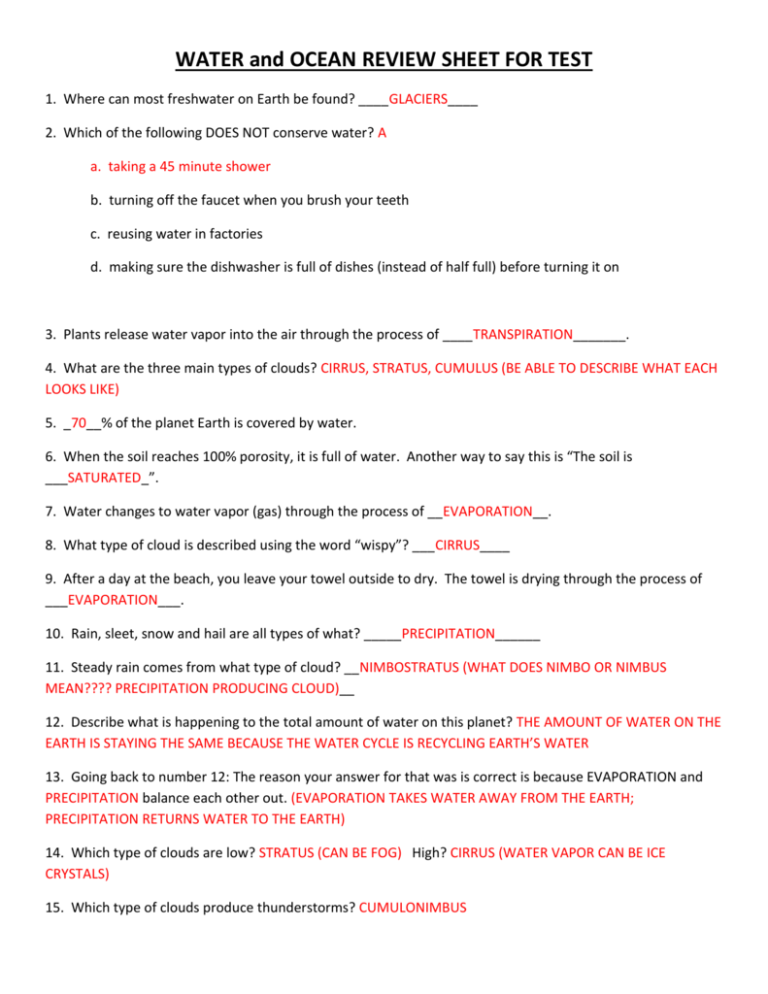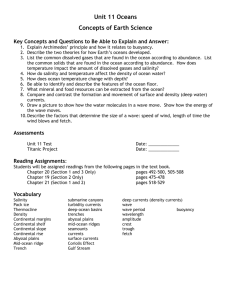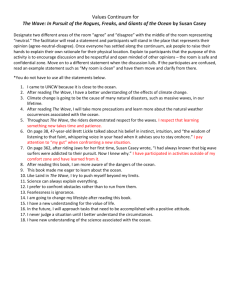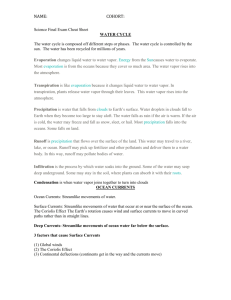WATER and OCEAN REVIEW SHEET FOR TEST 1. Where can most
advertisement

WATER and OCEAN REVIEW SHEET FOR TEST 1. Where can most freshwater on Earth be found? ____GLACIERS____ 2. Which of the following DOES NOT conserve water? A a. taking a 45 minute shower b. turning off the faucet when you brush your teeth c. reusing water in factories d. making sure the dishwasher is full of dishes (instead of half full) before turning it on 3. Plants release water vapor into the air through the process of ____TRANSPIRATION_______. 4. What are the three main types of clouds? CIRRUS, STRATUS, CUMULUS (BE ABLE TO DESCRIBE WHAT EACH LOOKS LIKE) 5. _70__% of the planet Earth is covered by water. 6. When the soil reaches 100% porosity, it is full of water. Another way to say this is “The soil is ___SATURATED_”. 7. Water changes to water vapor (gas) through the process of __EVAPORATION__. 8. What type of cloud is described using the word “wispy”? ___CIRRUS____ 9. After a day at the beach, you leave your towel outside to dry. The towel is drying through the process of ___EVAPORATION___. 10. Rain, sleet, snow and hail are all types of what? _____PRECIPITATION______ 11. Steady rain comes from what type of cloud? __NIMBOSTRATUS (WHAT DOES NIMBO OR NIMBUS MEAN???? PRECIPITATION PRODUCING CLOUD)__ 12. Describe what is happening to the total amount of water on this planet? THE AMOUNT OF WATER ON THE EARTH IS STAYING THE SAME BECAUSE THE WATER CYCLE IS RECYCLING EARTH’S WATER 13. Going back to number 12: The reason your answer for that was is correct is because EVAPORATION and PRECIPITATION balance each other out. (EVAPORATION TAKES WATER AWAY FROM THE EARTH; PRECIPITATION RETURNS WATER TO THE EARTH) 14. Which type of clouds are low? STRATUS (CAN BE FOG) High? CIRRUS (WATER VAPOR CAN BE ICE CRYSTALS) 15. Which type of clouds produce thunderstorms? CUMULONIMBUS 16. Fresh water found in the rock layers below our feet is known as GROUNDWATER. 17. If you see a(n) _ALTOCUMULUScloud in the morning, it could mean that you will see thunderstorms in the afternoon. 18. Water vapor changes to liquid water during the process of __CONDENSATION. 19. What water cycle process is responsible for cloud formation? ___ CONDENSATION ___ 20. For the water cycle to continue, it must get energy from the ____SUN________. 21. What percent of Earth’s water is saltwater? 97% (MOST FOUND IN OCEANS) Freshwater? 3% (MOST FOUND IN GLACIERS) 22. The ____WATER TABLE is the top of the saturated zone. 23. What is hydrology? THE STUDY OF EARTH’S WATER – HOW DOES IT MOVE, HOW IT IS DISTRUBUTED, WHAT IS THE QUALITY OF IT 24. You are a snowflake on top of a mountain. Describe 2 ways for you to get to the ocean. - YOU COULD MELT AND RUN DOWN A MOUNTAIN; YOU COULD THEN RUN INTO A STREAM THAT WOULD THEN JOIN A RIVER AND EVENTUALLY RUNOFF INTO THE OCEAN - YOU COULD BE MELT AND BE EVAPORATED INTO THE SKY; THERE YOU COULD CONDENSE INTO A CLOUD AND WHEN THE CLOUD BECOMES TO HEAVY YOU WILL FALL INTO AN OCEAN AS PRECIPITATION - YOU COULD MELT AND SINK INTO THE GROUND AND BE USED BY A PLANT; THE PLANT WOULD THEN TRANSPIRE, RELEASING YOU INTO THE ATMOSPHERE AS WATER VAPOR, WHERE YOU WOULD THEN CONDENSE INTO A CLOUD AND FALL INTO AN OCEAN AS PRECIPITATION _________________________________________________________________________________________ _________________________________________________________________________________________ 25. How are clouds important to the water cycle? ONCE EVAPORTATION TURNS WATER TO WATER VAPOR AND TAKES IT AWAY FROM THE EARTH TO THE SKY, IT CONDENSES INTO CLOUDS AND THE CLOUDS RETURN THE WATER TO THE EARTH AS PRECIPITATION 26. Name 2 things you can do to conserve water. TAKE SHORTER SHOWERS, TURN OFF WATER WHILE YOU ARE BRUSHING YOUR TEETH, ONLY RUN DISHWASHER WHEN IT’S FULL 27. How do waves move? UP AND DOWN (NO WATER MOVES FORWARD IN WAVES); THE PARTICLES IN A WAVE MOVE IN A CLOCKWISE, CIRCULAR MOTION 28. Label the parts of a wave on the following diagram: crest, trough, wavelength, waveheight, amplitude A. CREST B. IGNORE C. TROUGH D. WAVELENGTH E. AMPLITUDE A TO C = WAVE HEIGHT 29. Label the following diagram: continental slope, continental shelf, continental rise, guyot, seamount, mid-ocean ridge, trench CONTINENTAL SHELF VOLCANIC ISLAND ABYSSAL PLAIN CONTINENTAL SLOPE GUYOT MID OCEAN RIDGE CONTINENTAL RISE TRENCH 30. Currents that are caused by the wind are called __SURFACE CURRENTS____. 31. Underwater earthquakes create __TSUNAMIS_____. 32. The gently sloping area of the ocean floor that extends outward from the edge of a Continent is called the ___CONTINENTAL SHELF_____. 33. The flat region of the ocean floor is the __ABYSSAL PLAIN___. SEAMOUNTS 34. A deep canyon in the ocean floor is called a ___TRENCH______. 35. The long chain of underwater mountains is known as the ___MID OCEAN RIDGE_. 36. The highest part of the wave is called the ____CREST____. 37. The lowest part of the wave is called the ____TROUGH____. 38. Tsunamis have really long ___WAVELENGTHS OR WAVE HEIGHTS___. 39. The distance between one crest and another crest is the ___WAVELENGTH___. 40. One half the distance of the wave height is the __AMPLITUDE___. 41. As a wave reaches the shore, the _BOTTOM OF THE WAVE (OR THE TROUGH) of the wave drags along the bottom of the ocean. 42. Circulation in the ocean that brings deep, cold ocean water to the surface is known as __UPWELLING_____. 43. As a wave reaches the shore, the wavelength ___DECREASES____. 44. Currents that are due to differences in the amount of salt in the ocean are called ___DEEP OCEAN CURRENTS_____. (CAN ALSO BE CAUSED BY DIFFERENCE IN TEMPERATURE) 45. An ocean current is like a __RIVER running through the ocean. 46. The rise and fall of sea level is a _____TIDE_____. 47. __TIDE__ are caused by the gravitational pull of the moon. 48. Salinity is the measure of __SALT__ in the oceans. 49. A flat-topped, underwater seamount is called a ___GUYOT____. ** RIP CURRENTS are powerful currents that want to pull you back into the ocean.** 50. **** NEW QUESTION TO REVIEW!!! COMPARE AND CONTRAST SURFACE CURRENTS AND DEEP OCEAN CURRENTS. SIMILARITIES: THEY ARE BOTH LIKE RIVERS RUNNING THROUGH THE OCEANS (CURRENTS); THEY BOTH CARRY WATER FORWARD, UNLIKE A WAVE DIFFERENCES: SURFACE CURRENTS HAPPEN AT THE SURFACE OF THE WATER, WHILE DEEP OCEAN CURRENTS OCCUR DEEP IN THE OCEAN; SURFACE CURRENTS ARE CAUSED BY WINDS, WHILE DEEP OCEAN CURRENTS ARE CAUSED BY A DIFFERENCE IN SALINITY OR A DIFFERENCE IN TEMPERATURE







